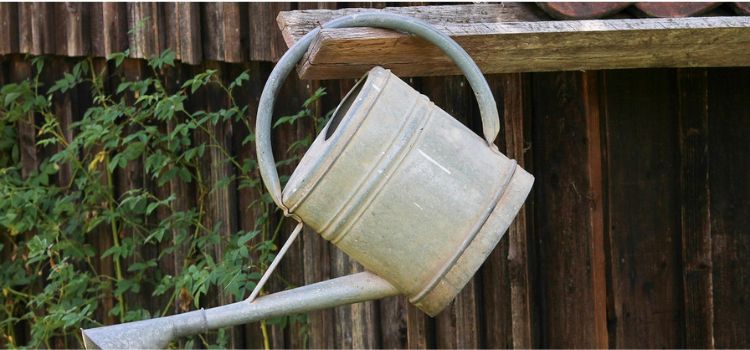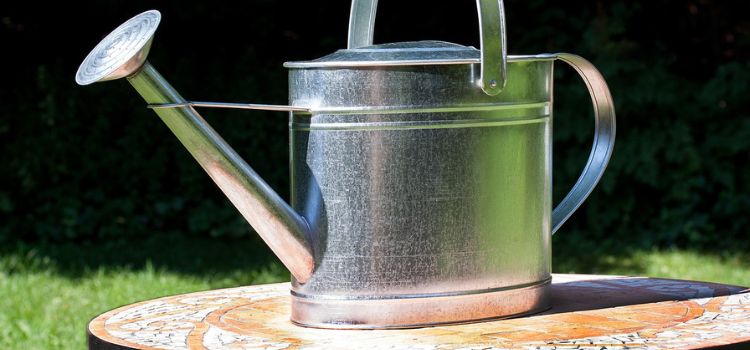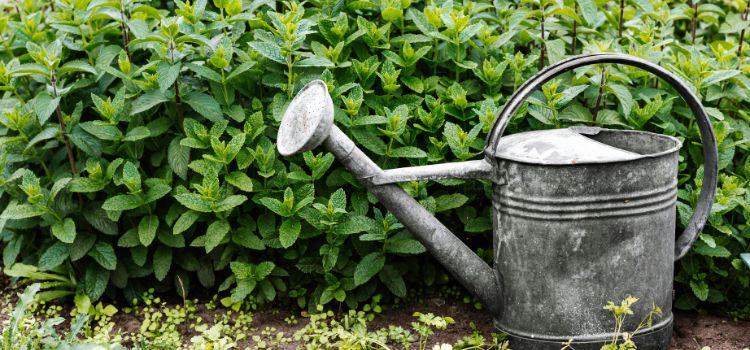As an Amazon Associate, I earn from qualifying purchases.
To fix a leaking watering can, first clean the affected area. Apply waterproof sealant or epoxy to seal the leak.
Leaking watering cans can be a nuisance, wasting water and reducing their efficiency. Identifying the leak source and addressing it promptly ensures the can’s longevity. Use waterproof sealants or epoxy adhesives to patch the hole effectively. These materials are readily available at hardware stores and are easy to apply.
Clean the area around the leak thoroughly before applying the sealant to ensure a strong bond. Allow it to dry completely before using the watering can again. Regular maintenance can prevent future leaks, ensuring your watering can remains in good condition for years. Properly fixing a leaking watering can save both water and money in the long run. I used this method and result is amazing.

Common Causes Of Leaks
Watering cans are essential tools for gardeners. They help keep plants hydrated. But sometimes, these cans start leaking. Understanding the common causes of leaks can help fix them.
Cracks And Holes
Cracks and holes are common in old watering cans. They often appear on the bottom or sides. These damages can cause water to leak out. Small cracks can be fixed easily. Larger holes may need more effort.
To fix cracks and holes, gather these materials:
- Waterproof tape
- Epoxy putty
- Sandpaper
Here’s how to repair the damage:
- Clean the area around the crack or hole.
- Use sandpaper to smooth the surface.
- Apply epoxy putty to seal the crack or hole.
- Allow the putty to dry completely.
- Cover the area with waterproof tape for extra protection.
By following these steps, your watering can should stop leaking. Always check for new cracks or holes regularly.
Worn Seals
Worn seals can also cause leaks. Seals are found at the joints of the watering can. They keep water from escaping. Over time, seals can wear out.
To fix worn seals, you’ll need:
- Replacement seals
- Wrench or pliers
- Lubricant
Follow these steps to replace worn seals:
- Identify the joints with worn seals.
- Use a wrench to loosen the joints.
- Remove the old seals carefully.
- Apply lubricant to the new seals.
- Place the new seals into the joints.
- Tighten the joints with a wrench.
New seals should stop the leaks. Make sure to check the seals regularly. This helps keep your watering can in good condition.
Materials Needed
Fixing a leaking watering can is easy and saves money. You need a few materials and some basic tools. This guide will help you get your watering can working again.
Tools For Repair
Start by gathering the right tools. Here is a list of tools you need:
- Sandpaper: To smooth the surface around the leak.
- Wire Brush: To clean the area before applying the sealant.
- Scissors: To cut patches or tape if needed.
- Cloth: For wiping and cleaning.
These tools are easy to find and cheap. You can find them at any hardware store. They help prepare the surface for repair. Clean surfaces make the sealant stick better.
Sealants And Adhesives
Choosing the right sealant is important. Here are some options:
| Type | Uses |
|---|---|
| Silicone Sealant | Good for small leaks. Easy to apply and dries fast. |
| Epoxy Resin | Strong and durable. Best for larger holes. |
| Waterproof Tape | Quick fix. Not as durable as other options. |
Each type has its pros and cons. Silicone is good for quick fixes. Epoxy is strong but takes longer to set. Tape is easy but may not last long.
Identifying The Leak
Fixing a leaking watering can is a simple task. Identifying the leak is the first step. Knowing where the leak is helps in fixing it quickly. This guide will walk you through the process.
Visual Inspection
Start by doing a visual inspection of your watering can. Place the can on a flat surface with good lighting. Look for any cracks or holes on the body of the can. Pay special attention to the seams and joints.
Here are some tips to help you find the leak:
- Check the spout: Sometimes, leaks occur where the spout connects to the can.
- Inspect the handle: The handle area can also have small cracks or holes.
- Look at the bottom: The base of the can is prone to wear and tear.
Use a magnifying glass if needed. Even small cracks can cause leaks. Once you identify the problem area, mark it with a pen or a piece of tape. This will make it easier to fix later.
Water Test
After the visual inspection, perform a water test. Fill the watering can with water. Make sure to fill it up to the brim. Place the can on a dry surface and watch for any leaks.
Here’s how to conduct a water test:
- Fill the can slowly: This prevents sudden bursts of water from hiding small leaks.
- Observe for drips: Look for water dripping from the marked areas.
- Check the surface: If the surface under the can gets wet, note the wet spots.
If you find water leaking, note the exact spots. This confirms the areas you marked during the visual inspection. A combination of visual and water tests ensures you identify all leaks.
Repairing Cracks
Fixing a leaking watering can is easy and fun. Cracks in the watering can can waste water and make gardening hard. Repairing cracks will help save water and keep your garden green. It’s simple, and you can do it with common tools.
Using Epoxy
Epoxy is a great way to fix cracks in a watering can. First, clean the area around the crack. Make sure it is dry and free of dirt. Next, mix the epoxy according to the instructions on the package. Use a small brush to apply the epoxy to the crack. Spread it evenly on the surface. Let it dry for at least an hour. Check the crack after the epoxy has dried. If the crack is still visible, apply a second coat.
Here are the steps to use epoxy:
- Clean the crack with a cloth.
- Mix the epoxy as the package says.
- Apply the epoxy with a small brush.
- Let it dry for one hour.
- Check the crack and apply more if needed.
Epoxy is strong and durable. It can last for many years. This method is perfect for metal and plastic watering cans. Always follow the safety instructions on the epoxy package. This method is very effective.
Applying Tape
Tape is another quick way to fix a leaking watering can. Waterproof tape works best for this job. Clean and dry the area around the crack first. Cut a piece of tape that is big enough to cover the crack. Make sure it extends a little past the crack on all sides. Place the tape over the crack and press down firmly. Smooth out any bubbles with your fingers.
Follow these steps to apply tape:
- Clean the crack with a cloth.
- Cut a piece of tape that is larger than the crack.
- Place the tape over the crack.
- Press down to remove air bubbles.
Tape is a fast and easy fix. It’s good for small cracks and temporary repairs. This method works best for plastic watering cans. Check the tape regularly to make sure it is still in place. Replace it if it starts to peel off.
Replacing Worn Seals
Fixing a leaking watering can might seem like a daunting task, but it’s quite simple. Replacing worn seals is one of the most common fixes. With the right tools and a bit of patience, your watering can will be as good as new.
Finding The Right Seal
First, you need to find the right seal for your watering can. Measure the diameter of the old seal. This ensures you get the correct size. Check the material of the original seal. It’s best to match it with a similar material.
Visit a hardware store or search online. Make sure to have your measurements ready. You can also take the old seal with you to compare. Look for seals that are durable and water-resistant. Some common materials include rubber, silicone, and neoprene.
Here is a quick checklist to help you:
- Measure the diameter of the old seal.
- Check the material of the old seal.
- Visit a hardware store or search online.
- Match the size and material.
- Choose a durable and water-resistant seal.
Doing a little research can save you time and money. Make sure to read reviews if you’re buying online. This will help you get a better idea of the product’s quality.
Installation Steps
Once you have the right seal, it’s time to install it. Start by removing the old seal. Use a small screwdriver or a similar tool. Be careful not to damage the watering can. Clean the area where the old seal was. Make sure there is no dirt or debris.
Next, place the new seal in the same spot. Make sure it fits snugly. Press it down firmly to ensure it stays in place. If the new seal is too loose, it might not work properly.
Here’s a step-by-step guide:
- Remove the old seal with a small tool.
- Clean the area where the old seal was.
- Place the new seal in the same spot.
- Press down firmly to secure the new seal.
Test the watering can by filling it with water. Check for any leaks. If you see any, press the seal down again. Make sure it’s in the right position.
In summary, replacing a worn seal is easy if you follow these steps. A little effort can save you from buying a new watering can.
Testing For Effectiveness
Fixing a leaking watering can might seem tricky, but it’s quite simple. Testing for effectiveness is crucial. A proper fix ensures no more leaks and happy plants. This guide helps you through the steps to fix your watering can and check its efficiency.
Fill And Check
First, fill the watering can with water. Make sure you fill it up to the brim. Observe the can closely to find the leak. You might see water dripping or a small puddle forming. Mark the leaking spot with a waterproof marker.
Next, dry the can completely. Use a towel or let it sit in the sun. Once dry, apply a waterproof sealant on the marked spot. Ensure the sealant covers the area thoroughly. Let the sealant dry according to the instructions on the product.
Fill the can with water again. Check if the leak is fixed. If there’s no leak, the fix worked! If it still leaks, you might need to reapply the sealant or use a different product.
- Find the leak by filling the can.
- Mark the spot with a marker.
- Dry the can and apply sealant.
- Test again by filling it with water.
Monitor For Future Leaks
It’s important to keep an eye on your watering can. Check it regularly for any new leaks. Inspect the sealant to ensure it’s holding up. Over time, the sealant might wear off, especially if the can is used frequently.
Store the watering can properly when not in use. Avoid leaving it in harsh weather conditions. Extreme heat or cold can cause the material to weaken and develop new leaks. Regular cleaning helps maintain the can’s condition. Rinse it out and let it dry completely before storing.
If you notice any new leaks, repeat the repair process. Prompt attention can prevent bigger problems. Use quality sealant for long-lasting results.
| Tips | Details |
|---|---|
| Regular Checks | Inspect for leaks every month. |
| Proper Storage | Store in a cool, dry place. |
| Quality Sealant | Use a trusted brand for repairs. |
When To Replace
Fixing a leaking watering can can save you from unnecessary expenses. Sometimes, it is best to replace the can. Knowing when to fix and when to replace is key. Let’s explore both aspects.
Signs Of Irreparable Damage
Some damages are beyond repair. Rust is a major sign of irreparable damage. If the rust has eaten through the metal, it cannot be fixed. Cracks in plastic watering cans are also a problem. These cracks often grow larger over time.
Here are some clear signs:
- Large holes that can’t be patched
- Broken handles making the can hard to carry
- Severe rust that weakens the structure
- Cracks that leak water continuously
Sometimes, a warped shape can indicate damage. This makes the can hard to use. If your can has multiple issues, it might be time to get a new one.
Choosing A New Watering Can
Picking a new watering can involves several factors. First, think about the material. Metal cans are sturdy but can rust. Plastic cans are light but can crack. Look for a can with a comfortable handle. This makes watering easier.
Capacity is another factor. Smaller cans are good for indoor plants. Larger cans are better for gardens. Spout design also matters. A long spout helps reach plants in the back. A wide spout is good for watering many plants at once.
Here is a table to help you choose:
| Material | Pros | Cons |
|---|---|---|
| Metal | Sturdy | Can rust |
| Plastic | Lightweight | Can crack |
| Ceramic | Decorative | Fragile |
Always check the warranty and reviews before buying. This ensures you get a good quality can.

Frequently Asked Questions
How Do I Identify A Leak In My Watering Can?
To identify a leak, fill the watering can with water. Observe for any dripping or wet spots. Check the seams and spout carefully.
What Materials Do I Need To Fix A Leaking Watering Can?
You will need waterproof adhesive, a patch kit, or silicone sealant. Ensure you have sandpaper and a clean cloth for preparation.
Can I Use Waterproof Tape To Fix The Leak?
Yes, waterproof tape can temporarily fix small leaks. Clean and dry the area before applying the tape for best results.
How Long Does It Take To Repair A Watering Can?
The repair process usually takes about 30 minutes. This includes cleaning, applying the fix, and allowing it to dry properly.
Conclusion
Fixing a leaking watering can is easier than you might think. With simple tools and steps, you can restore it. Follow our guide to save time and money. Keep your garden thriving with a functional watering can.
Happy gardening!

